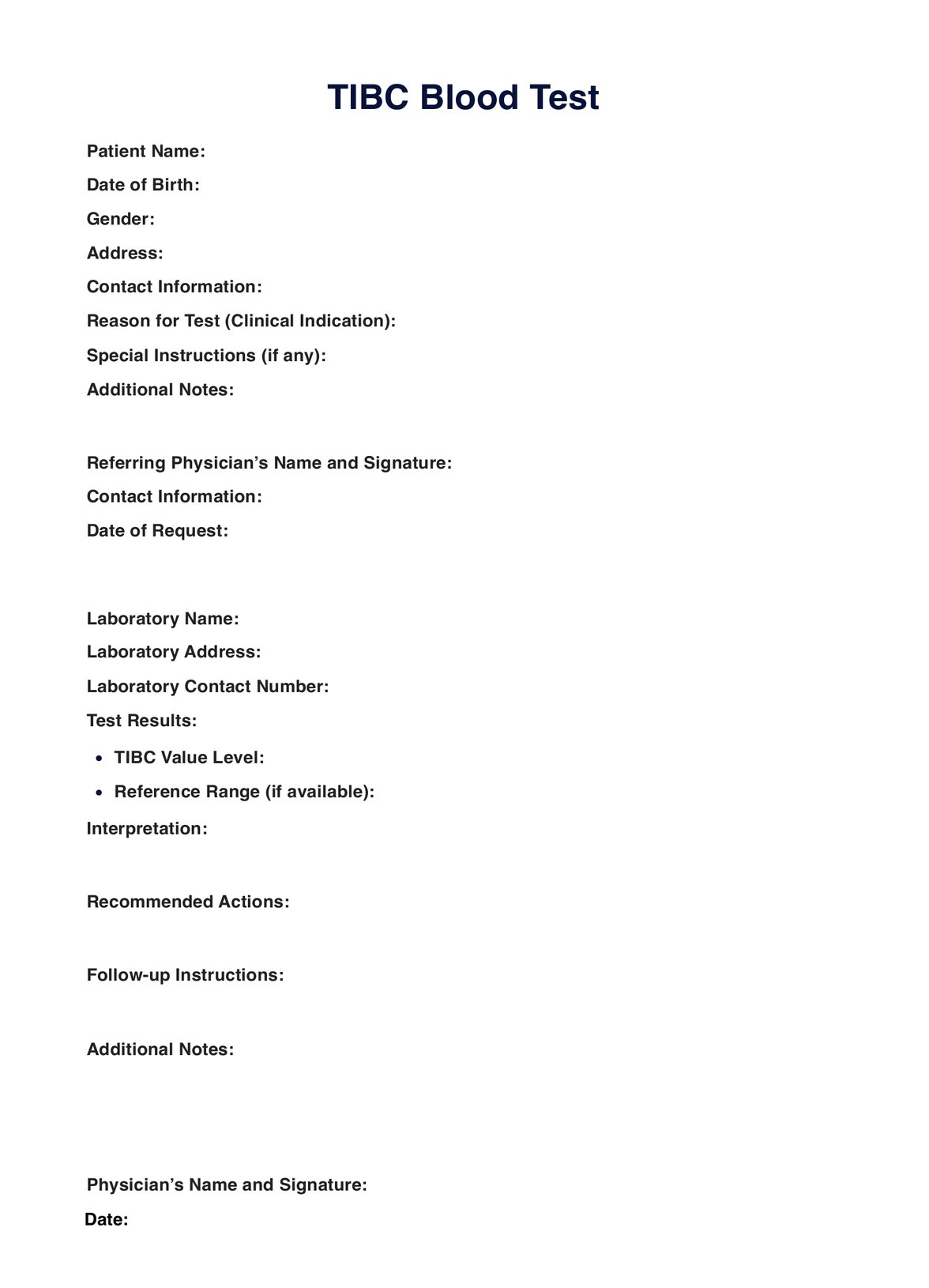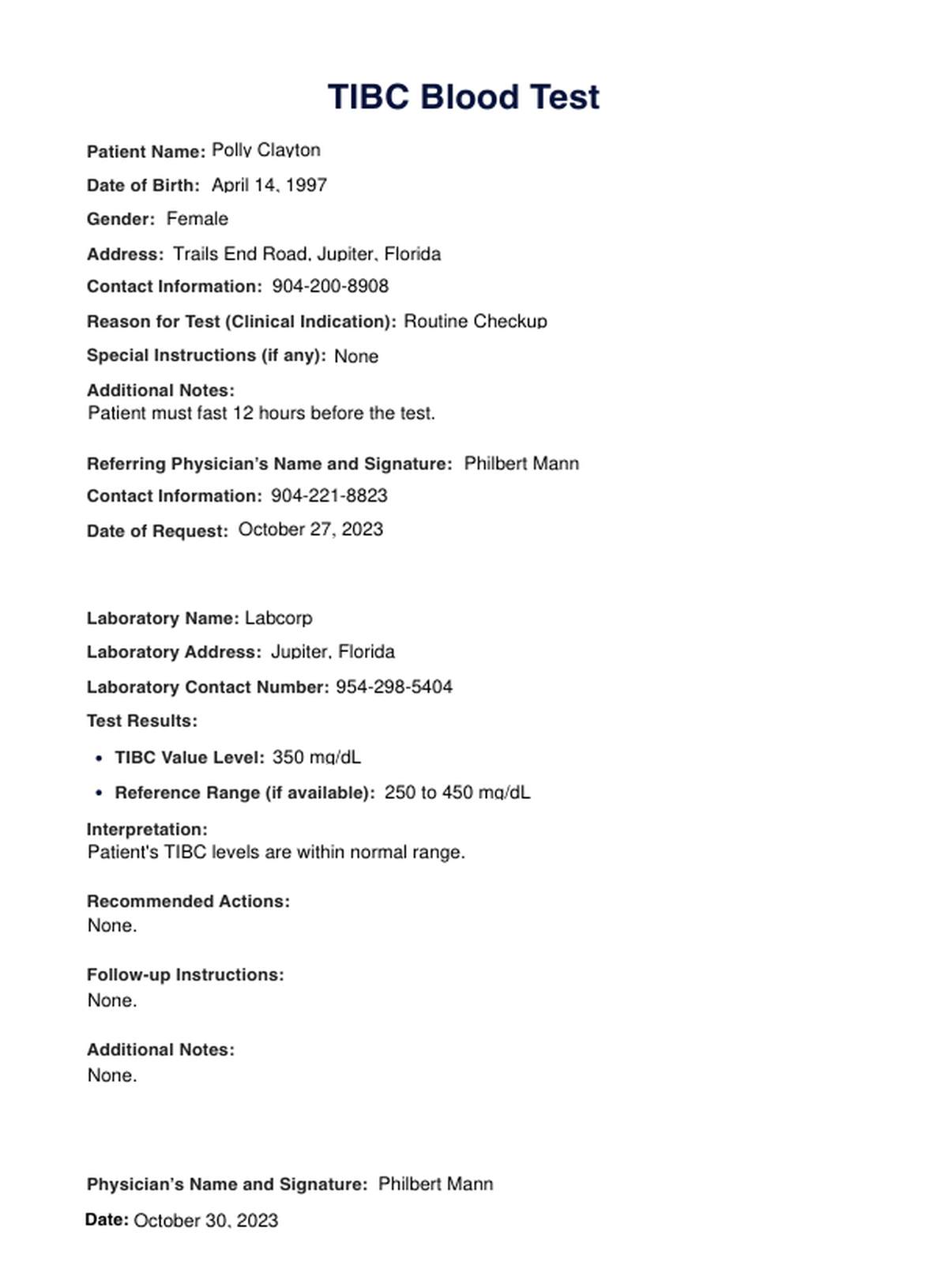TIBC Blood Test
Explore the clinical uses and result interpretations of the TIBC blood test with our guide, and enhance health. Click here for details and to download our free template.


What is a TIBC Blood Test?
A TIBC or Total Iron-Binding Capacity blood test is a medical test that measures the blood’s capacity to bind and transport iron throughout one’s body. To be more specific, the test quantifies the amount of transferrin which is a protein that’s synthesized by the liver that’s responsible for regulating the iron’s absorption into the blood. The TIBC blood test is valuable because of its role in forming healthy red blood cells in charge of conveying oxygen from the lungs to different tissues and maintaining the function of muscles, bone marrow, and organs. Compared to the ferritin test, which is also a medical test related to iron levels, the TIBC specifically evaluates how the body transfers iron through transferrin. The ferritin, on the other hand, checks the quantity of iron in the cells.
TIBC is typically requested and used when the practitioner suspects their patient has iron-related conditions like iron-deficiency anemia or hemochromatosis. If not, because of those, the patient’s TIBC may be measured when the patient undergoes an iron panel which includes a combination of TIBC blood test, fasting iron blood test, ferritin blood test, and percentage transferrin saturation test. Test results are more likely accurate if the practitioner fasts 12 hours before the test and avoids any iron supplements during the fasting period.
TIBC Blood Test Template
TIBC Blood Test Example
How Does it Work?
Step One. Secure a Template Copy
Procure a digital and printable copy of the TIBC blood test template you can bring out when needed. Access and download a copy by doing either of the following:
- Clicking the “Use Template” or “Download Template” button
- Searching “TIBC” on Carepatron’s template library’s search bar on the app or website
Step Two. Make a Request
Fill out every possible information on the template, including any observations or findings. Whatever information you get when you interview, assess, or examine your patient can be the reason why your patient should undergo the test.
Step Three. Show the Form
Depending on the test’s purpose, you, your patient, or a fellow healthcare practitioner caring for the same patient can show the form as proof to a phlebotomist or the practitioner in charge of collecting the blood sample.
Step Four. Note Observations and Findings
As soon as the results are within your grasp, you can proceed to analyze and interpret them during your next consultation with your patient. Create a reference that you and your client can easily check when understanding the condition, diagnosing, or formulating a treatment by writing down your observations and findings in the document section of the template.
Step Five. Securely Store the Template
Done with making the most out of the template either as a request form and/or document section of the template? Remember to store the template securely. If you use a digital copy, it’s recommended that you store it in HIPAA-compliant software like Carepatron that can guarantee to safeguard electronic patient records.
When Would you use this Test?
The Total Iron-Binding Capacity or TIBC blood test is a valuable diagnostic tool used for multiple reasons in different scenarios. Here are examples of when and why a healthcare practitioner may request a TIBC test:
Part of a Comprehensive Iron Assessment
Oftentimes, TIBC tests are included in the iron panel, which is a comprehensive assessment of an individual’s iron status. Aside from the TIBC test, additional tests are included in an iron panel, like a fasting iron blood test and a ferritin blood test that evaluates iron metabolism more thoroughly.
Confirming Suspicions and Diagnosing
If a practitioner suspects that the patient has an iron-related issue as seen from any indications or symptoms, they may have iron deficiency anemia which is a condition wherein there’s an insufficient amount of iron in the body, or hemochromatosis which is a condition characterized by an excessive accumulation of iron in one’s body.
Monitoring
When a patient is diagnosed with an iron-related condition or is undergoing treatment for having such conditions, healthcare practitioners may request a TICB test to monitor their iron levels.
If there are any circumstances or scenarios wherein you feel like your patient will benefit from undergoing a TIBC blood test, you may request one for your patient.
What do the Results Mean?
Interpreting and noting your patient’s results on your free TIBC blood template is vital in assessing your patient’s iron status and iron-related health conditions. And although you must consider multiple factors like the patient’s history, symptoms, and other test results if you need some guidance, here are some general guidelines:
Within Normal Range
If your patient’s levels are within 250 to 450 mg/dL or 44.8 to 80.5 mmol/L, they are within normal range, and their body’s iron transport capability via transferring is functioning as expected.
Low TIBC Levels
If your patient’s levels are below the lower limit, your patient may have a condition causing an excess of iron in their body. To identify the cause, you may want to have them further tested for inflammation, poisoning, hemochromatosis, sickle cell anemia, or thalassemia. Do note, though, that there are circumstances wherein patients with an iron overload will still have TIBC levels within normal range.
High TIBC Levels
If your patient’s levels are above the upper limit, it typically indicates iron deficiency compared to the abundance of available transferrin.
You may use the interpretations you’ve made within context to either make an accurate diagnosis or recommend appropriate treatment options.
Research & Evidence
There has been research surrounding the TIBC (Total Iron-Binding Capacity) blood test that has revealed its significance in diagnosing and monitoring conditions related to iron metabolism. Here are points from two articles that underscore the importance of the blood test because of its discovered purpose:
According to the articles found on reputable medical websites, the TIBC test has been useful as a diagnostic tool to identify iron-related conditions like anemia and hemochromatosis, evaluate the overall health of a patient, and create effective treatment plans for patients diagnosed with said iron-related conditions. Aside from that, the test also plays a huge role in guiding medical interventions based on a patient’s iron status.
To further cement the importance of the TIBC blood test, there’s a study entitled “Total iron binding capacity (TIBC) is a potential biomarker of left ventricular remodeling for patients with iron deficiency anemia” that was published in BMC Cardiovascular Disorders that emphasizes the importance of the existence of the TIBC blood test because of the value of TIBC. According to their findings, TIBC can be used as a potential biomarker for left ventricular remodeling in patients with iron deficiency anemia because of the association between TIBC and the left ventricular mass index. Furthermore, because of the logistic analysis done in the study, it’s confirmed that the TIBC also has a role in predicting any abnormal LVMI inthe patient population. The whole study, therefore, supports and emphasizes the clinical utility of the test when assessing cardiac health when considering iron deficiency.
To conclude, research has highlighted the clinical relevance of the TIBC blood test, making it a valuable tool to healthcare practitioners worldwide when it comes to assessing and managing iron-related conditions.
References
- Chen, Y., Wan, J., Xia, H. et al. Total iron binding capacity (TIBC) is a potential biomarker of left ventricular remodelling for patients with iron deficiency anaemia. BMC Cardiovasc Disord 20, 4 (2020). https://doi.org/10.1186/s12872-019-01320-3
- HRF. (n.d.). HRF. https://healthresearchfunding.org/
- Professional, C. C. M. (n.d.). TIBC (Total Iron-Binding Capacity) test. Cleveland Clinic. https://my.clevelandclinic.org/health/diagnostics/24979-total-iron-binding-capacity-tibc
Commonly asked questions
General physicians, their assistants, nurses, and a specialist like a hematologist are the healthcare practitioners who typically request a TIBC blood test.
TIBC blood tests are typically requested during an iron panel and used to confirm suspicions/diagnosis or monitor an existing condition and their treatment.
Collection will only take a few minutes, but typically results will take around 1 to 2 days to come back. Do note that it can take as long as three days, depending on the laboratory.
















































































































